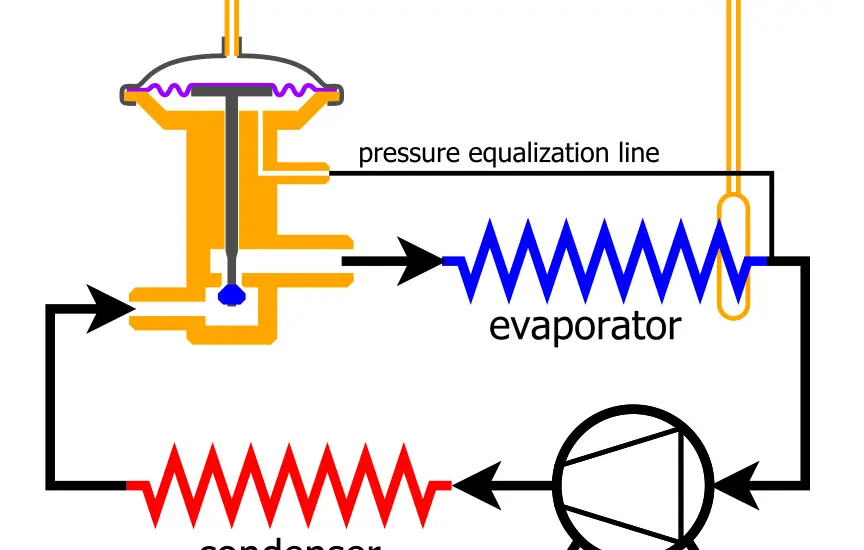In this article, we’ll walk you through the key expansion valve symptoms, including those that occur when the valve is stuck closed or open, and provide detailed instructions on how to diagnose and resolve these issues.

Table of Contents
Expansion Valve Symptoms
Identifying expansion valve symptoms early is crucial to maintaining the performance and longevity of your cooling or heating system. Here are detailed explanations of common signs that may indicate a problem with the expansion valve:
Insufficient Cooling or Heating
This can be one of the first noticeable expansion valve symptoms. If the valve is stuck closed, the flow of refrigerant to the evaporator coil is restricted, leading to inadequate cooling or heating.
Conversely, if the valve is stuck open, too much refrigerant will flow into the evaporator coil, which can cause overcooling or overheating. In either case, the system won’t maintain the desired temperature, leading to discomfort and inefficiency.
Noise Coming from the Valve
Any unusual or loud noises coming from the valve area may signal that the valve is not functioning correctly. A stuck valve might produce a humming or buzzing sound.
These sounds may be indicative of mechanical failure within the valve, or they could be a sign that the valve is clogged with debris. Immediate investigation by a professional is advised as this could lead to more serious problems.
Unusual Fluctuations in Pressure
The expansion valve is designed to balance the pressure between different parts of the cooling or heating system. If you notice fluctuations in the system’s pressure, this could signal a problem with the valve’s ability to maintain this balance.
Pressure readings that are too high or too low can cause other components of the system to fail, leading to costly repairs. Regular pressure monitoring is vital to catch this symptom early.
Frost Buildup
If the valve is stuck open, it might cause an excessive flow of refrigerant into the evaporator coil. This can lead to a drop in temperature in the coil, causing frost to build up on its surface.
Frost buildup reduces the efficiency of the heat exchange process and can ultimately damage the evaporator coil. It’s a visible sign that something is wrong with the valve and should be addressed promptly.
In addition to these symptoms, it’s worth noting that some expansion valve issues might be more subtle and may require professional diagnosis. Regular maintenance checks by trained technicians can help identify and fix problems before they escalate.
If you notice any of the above expansion valve symptoms or suspect something might be wrong, don’t hesitate to consult with a professional. Early diagnosis and repair can save time, and money, and prevent unnecessary stress.
Check out these other related articles…
5 Expansion Valve Stuck Open Symptoms: A Comprehensive Guide
4 Stuck Expansion Valve Symptoms: A Complete Guide
Clogged Expansion Valve Symptoms: A Complete Guide
How to Test Expansion Valve in 6 Easy Steps
Expansion Valve Troubleshooting: 4 Easy Steps to Follow
Electronic Expansion Valve Controller: A Comprehensive Guide
Diagnosing Expansion Valve Problems
Diagnosing expansion valve problems involves a methodical approach:
Visual Inspection: Check for visible signs of wear or damage, including expansion valve o rings.
Operational Testing: Test the valve’s operation by monitoring the cooling or heating performance of the system.
Pressure Monitoring: Use pressure gauges to check the system’s pressure levels and look for irregularities.
If you need pressure guages to monitor your system’s pressure, you can check out the Orion Motor Tech AC Gauges on Amazon.
Consult a Professional: If unsure, consult with a trained HVAC technician to perform a detailed diagnosis.
How to Fix Expansion Valve Issues
Once you’ve identified the expansion valve symptoms, the next step is to fix the issue:
Cleaning: Sometimes, dirt and debris can cause the valve to stick. Cleaning it may resolve the issue.
Adjusting: If the valve is misaligned, adjusting it to the correct position can correct the problem.
Replacing: If the valve is damaged beyond repair, replacing it with a new one is the best solution.
Seek Professional Help: If you’re unsure about the repair process, seek professional assistance to ensure the job is done correctly.